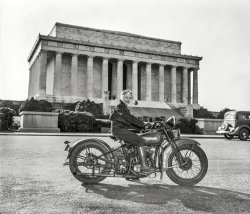
MAY CONTAIN NUTS

Search Shorpy
SHORPY ART

Framed or unframed, desk size to sofa size, printed by us in Arizona and Alabama since 2007. Explore now.
Join and Share
Ad-Free Shorpy
Shorpy is funded by you. Patreon contributors get an ad-free experience.
Learn more.

Recent comments
- Baldwin 62303
- Baldwin VO-1000
- Cold
- No expense spared
- Tough Guys
- Lost in Toyland
- And without gloves
- If I were a blindfolded time traveler
- Smoke Consumer Also Cooks
- Oh that stove!
- Possibly still there?
- What?!?
- $100 Reward
- Freeze Frame
- Texas Flyer wanted
- Just a Year Too Soon
- WWII -- Replacing men with women at the railroad crossing.
- Yes, Icing
- You kids drive me nuts!
- NOT An Easy Job
- I wonder
- Just add window boxes
- Icing Platform?
- Indiana Harbor Belt abides
- Freezing haze
- Corrections (for those who care)
- C&NW at Nelson
- Fallen Flags
- A dangerous job made worse
- Water Stop
Member Photos
The Shorpy
Print Emporium
Print Emporium
Search Shorpy
Search results -- 30 results per page
- Pan-American: 1935
- ... as it doesn't flex under side forces.
Otherwise the bike goes unstable. The front bag looks bad in this regard unless it's all ... front basket I had on my one speed J.C. Higgins nerd bike when I was a kid so I could deliver papers.
It had so much weight ... Posted by Dave - 10/18/2015 - 7:32pm -
![Pan-American: 1935 Ready for international bicycle ride. Henry G. Slaughter of Washington, supported by those interested in publicizing the Inter-American Highway, prepares to leave for a trip which will carry him, if he is successful, down into the tropics through Central America to the Argentine.
November 23, 1935. Washington, D.C. "Henry G. Slaughter." Harris & Ewing Collection glass negative. View full size.
BustA blurb in the Loredo Times from Feb. 6, 1936 reported that Mr. Slaughter decided to abandon "the idea." He had written a friend that he had encountered delays in entering Guatemala on account of very strict laws of entry, and now that the rainy season had begun in that country he had decided to abandon the trip. By June 1936, however, The Carthage Watchman reported that Henry and his handlebar-based typewriter were about to make a second attempt.
Foot HelpI have no idea what was available back in the day, but riding without at least toe clips makes it a lot harder when climbing.
I logged many thousand miles on a bicycle back in the 1970s
including a parts of Montana and Wyoming in 1976.
Gee, I wonder why my knees hurt so much these days?
If you look hardyou can see the revolution counter on the front fork and the pin to turn it on one of the spokes.
I'll wager -I'll bet that he doffs his necktie before he reaches San Luis Obispo.
[Which would have been a major detour on a trip from D.C. to Argentina. - Dave]
Wobble InstabilityYou can pile any amount of stuff as high as you want on a bicycle so long as it doesn't flex under side forces.
Otherwise the bike goes unstable. The front bag looks bad in this regard unless it's all rigid. Also it blocks his light from shining on the road, which in 1935 is surely all potholes.
So I'd guess he didn't make it, unless he piled the front bag in the back and strapped it down.
Incomplete PreparationThis guy isn't fully prepared for such a long trip and doesn't appear to understand what's cool.
For example, he has no streamers coming out of his handlebars, and no playing cards rubbing against his spokes. Nor does he have a hub polisher on either wheel.
Not to mention he's not wearing a bow tie and a houndstooth suit.
Pure Amateur Hour.
I bet he didn't make it.
Story of EvolutionEarly nerd.
Panama or BustHenry had just left San Antonio, Texas and bound for Panama a week after this photo, Methinks there are some inaccuracies abounding. See attached article from the San Antonio Light, published 30 November 1935.
Not So Fast!Seems Henry did make it as far as Panama. May of 1936 had him in front of the US Capitol after a 3400 mile trip. He made the front page of the Erie County Independent. (NY)
At that point he has a typewriter attached to his handlebars to ". . . type notes. . . " - I bet the paper was beat up by the bottom of the page.
Pith Helmet and Linemans bootsJust like they use in the Tour de France.
Wobble InstabilityForgive me for posting twice, but rhhardin's comment about Wobble Instability reminded me of the enormous front basket I had on my one speed J.C. Higgins nerd bike when I was a kid so I could deliver papers.
It had so much weight forward, especially with a load of papers, that I had to be extremely careful making turns, and I dumped it more than once.
I learned to hate that hill I had to climb halfway through my route, and envied those "rich kids" who had parents that could afford one of them "English racers".
(The Gallery, Bicycles, D.C., Harris + Ewing)](https://www.shorpy.com/files/images/SHORPY-39654a.thumbnail.jpg)
- Look, Ma: 1921
- ... of someone's fingers intertwined within the spokes of a bike must be the visual equivalent of nails on a chalkboard because this photo, ... they made buckets of money and had tons of fun with their bike tricks.
Fixee That's one heckuva track stand!
Sprockets Yes, ... Posted by Dave - 08/13/2013 - 4:06pm -
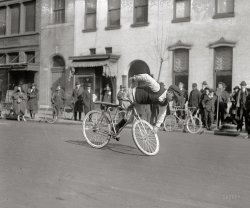
- Going Nowhere: 1930
- ... Ridge Mountains. Today, its right-of-way is a much-used bike path that stretches from the west end of Alexandria west, passing through ... Posted by Dave - 07/22/2012 - 6:43pm -
![Going Nowhere: 1930 "Car interior. Washington & Old Dominion R.R." Our third and final look at Pennsy car 4928 on the tracks of the W. & O.D., whose right-of-way is now plied by commuters taking I-66 into Washington. 8x10 glass negative. View full size.
Next stop, Willoughby!It looks like the old railroad car in that "Twilight Zone" episode.
Is ComfyIt IS more comfy than a modern jetliner. I volunteer at a railroad museum where we refurbish and display old RR cars and have sat in many of these. The seats are like your couch at home; there is more than ample room to cross your legs and the passenger next to you can still get up and leave his seat without tripping over your legs. Some of the newer (1920s-30s) ones have pivoting seats that let the whole bench swivel toward the aisle.
Like so many modern things, the "good" has been engineered out of it. We used to get things such as durability and ruggedness for free, but now it's all designed out as unnecessary, as exemplified by the sardine-can seating of modern airliners.
[I'll bet airplane seats are pretty durable. And of course there's a reason airline seats are closer together. The per-mile cost of moving a pound of passenger through the air is much higher than it is on the ground. - Dave]
ContrastWhile a bit seedy and mussed up, the interior of Old 4928 looks fairly decent. Like an old dowager queen waiting for a rescuer, hoping for salvation. But, alas, it probably never came and we are the worse off for that.
The W&OD lives, sortaThe Washington & Old Dominion ran from Alexandria out to Purcellville in the Blue Ridge Mountains. Today, its right-of-way is a much-used bike path that stretches from the west end of Alexandria west, passing through wooded areas, suburban sprawl, and eventually rural stretches as it gets outside the Washington Beltway. It's a wonderful trail to ride.
Most folks don't realize that one small (maybe a mile or two) of the RR still is in daily use: the stub that goes from the former Potomac Yard (and Conrail/Amtrak mainline) east into Old Town Alexandria, dead-ending as siding at the warehouses on the banks of the river. On a daily basis, two- and even three-engine trains of boxcars and coal hoppers pass by my office window, servicing the coal-fired Mirant power plant and the riverfront warehouses. With Old Town becoming increasingly an upscale tourist destination, it's nice to have reminders that it's still a working port!
W&ODI-66 does not follow the W&OD Railroad. The W&OD's right of way is instead now a trail, from Shirlington to Purcellville. The right-of-way west of Purcellville was sold before the rest of it, so it will likely never extend further west than that.
[I-66 uses two stretches of W&OD right-of-way through Arlington. - Dave]
Looks ComfyThis car looks about 1000 times more comfortable than the coach seats in a modern jetliner (and the TGV trains in Europe for that matter).
Doesn't look comfortableHard wooden armrests, scratchy fabric, no headrests, and no lumbar support all add up to uncomfortable in my book.
All Aboard...When I was a child, and the Pennsylvania Railroad had not yet become Penn Central, there were still 1910-1938 era cars in use similar to this one.
Far from being uncomfortable, they had soft mohair seats with very plush and pliable springs, and those seatbacks could be shifted to the front or back of each bench, allowing one to ride facing forward, back, or to create two adjacent seats that faced each other for a cozy group alcove. None I ever rode on had carpet runners like this one. They had linoleum or tile.
The thing you cannot see in the picture is how noisy those very oldest cars were to ride in. The windows, when they were wood, banged, and the tracks were not yet welded into a seamless beam (done for the Metroliner in the 1970's), so at every segment of rail the windows rattled and the train went clack-clack-clack.
The silversides of today are quiet and smooth riding, but they have none of the art deco and pre-WWI charm of these cars. Each train ride was an excursion into art history. You never knew in advance what art era you would be studying.
W&OD TrailHere's a map showing the trail.
(The Gallery, D.C., Harris + Ewing, Railroads)](https://www.shorpy.com/files/images/20625a0.thumbnail.jpg)
- Bridges of Pittsburgh: 1905
- ... are now home of Pittsburgh University. And there's a great bike trail where those rail cars and the mill once sat. This is all less than a ... Posted by Dave - 07/28/2012 - 4:55pm -
![Bridges of Pittsburgh: 1905 Circa 1905. "Pittsburgh from Mount Washington -- Monongahela River with Smithfield Street Bridge and Pan Handle Bridge." Panorama made from two 8x10 inch dry plate glass negatives. Detroit Publishing Company. View full size.
Little engine that couldThe steam locomotive bottom left has me wondering. Upon magnification it appears to be numbered 301, but can't quite make out the number, railroad initials or wheel arrangement. If this is the Monongahela Railroad the initials could be PRR or P&LE. They did acquire two class D-3 locos in 1904 and 1905 with a 4-4-0 wheel arrangement AND they were numbered 301 and 302. Then there was a 2-8-0 arrangement purchased in 1903 if the number is 201. Oh well, regardless of identity it certainly looks like an "engine that could" do its duty.
Topography underneath the cityWhat I love about this shot is you can see the topography that lies beneath all the buildings of Pittsburgh today.
The HillGreat shot of the East side of the city. Long before Boulevard Of The Allies and the Parkway took over the landscape. Those barren hills to the North are now home of Pittsburgh University. And there's a great bike trail where those rail cars and the mill once sat. This is all less than a mile from my place. I never get tired of looking at the old shots of this city and seeing how it has evolved into what it is today.
LOTS to LQQK at!!!That is just a totally awesome photo right there with lots and lots of stuff to look at. Just the railroad stuff (my favorite subject) can amuse one for hours. All those passenger and freight cars and rail served industries and in 1905 they probably kept track of where everything was and where it was going than they do now with computers, GPS tracking and less rolling stock and rail served industry!
In looking at the sky, though, one should be glad we DO have an EPA now. Of course, I suspect there may be just as many pollutants in the air now, it's just that we have cleaned them up so that you can't see them or smell them as well.
[Your suspicion is incorrect. The air here was much dirtier a century ago. - Dave]
I suspect you're right. --RJ--
Air QualityMeasured not in picograms per cubic liter, but in lbs. of cinder per cubic foot. Holy moley - that is dirty-ass air!
The little engineis a 4-4-2, presumably a P&LE class E-1 engine.
Jim CrowOf interesting note is the combination and coach in the yard near the Atlantic (4-4-2) locomotive. Though more than likely they are currently in storage, it's probable that the cars came off a train oriented like that. You saw that type of orientation quite often in the time of segregation, with black riders being placed in the section forward of the baggage compartment, and whites riding in the rest of the train. This gave rise to calling the orientation "Jim Crow." It would later be applied to special "Jim Crow" cars which had the baggage compartment in the middle of the car and passengers on either end.
(Panoramas, Boats & Bridges, DPC, Pittsburgh, Railroads)](https://www.shorpy.com/files/images/SHORPY_Pittsburgh_Panorama.thumbnail.jpg)
- Take a Letter: 1920
- ... at.
In 1920 You didn't have to lock up your bike in DC.
Competent Secretaries Both of the following are 1920 ... Posted by Dave - 08/13/2013 - 3:56pm -
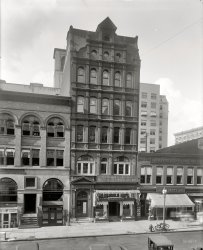
- Cowboy Tricycle: 1963
- ... Dad on a trike? There is the picture of your brother on a bike that says 1968. Love all the photographs you post.
[You are ... Posted by Tony W. - 09/17/2011 - 8:06pm -
![Cowboy Tricycle: 1963 This picture of my dad was taken on Christmas Day, 1963. I thought it fitting to post this after seeing tterrace's tricycle picture. I guess the whole dressing up like a cowboy and riding tricycles thing was popular for a while. View full size.
The Right StuffNow this is a real tricycle (i.e., like mine): all made out of metal and rubber. I realize the kids of my nephew's generation thought that Big Wheels were the coolest things ever, but to me they were tacky, garish, disposable polyethylene abominations. Not to put too fine a point on it.
So cute!What a cute little boy - and I think we had that exact carpet also!
What A Machine & Look At That Tinsel!!! I had an old trike that was all metal & had real rubber tires as well; when your little they seemed to weigh a ton! But tterrance don't knock Big Wheels; we would take ours & ride them in the creek- they would FLOAT!!!! I would never have dared to try that with my 1-ton trike and not in the deep parts for sure :-() !!!!
Ride 'em cowboy!Talk about mixed metaphors! Cowboy on a trike? I had a "horse" a few years after this--a green Sting Ray! Sooo, I was a cowgirl with a banana seat.
You dad was a super cute kid!
'65 StangOK, I may not have ever gotten the Big Wheel I wanted but my trike was EXACTLY like this, except red. That 1965 Mustang peddle pedal car I mentioned was this color (Gold), though.
And I had a Stingray with a Banana seat, too, just a couple years later.
1963?Is that date right for your Dad on a trike? There is the picture of your brother on a bike that says 1968. Love all the photographs you post.
[You are confusing photos posted by two different people. Pay attention, class. - Dave]
Your Dad in '63If this is your Dad, He doesn't look much older than you and your brother in the '68 photo.
[You're confusing Tony W. with bhappel. - Dave]
This isAdorable.
Your DAD?Man, that makes me feel really old!
Confusing Tricycles>> You're confusing Tony W. with bhappel. - Dave
And what's hilarious (to me) is that my father was called Tony (given name Anton) and had the middle initial of "W"!
(ShorpyBlog, Member Gallery, Christmas, Kids, Tonypix)](https://www.shorpy.com/files/images/DadChristmas1963.thumbnail.jpg)
- Tall Beer: 1900
- ... this era, bicycles stand upright next to curbs (obviously, bike thieves were rare in those days). None are ever seen as having fallen ... Posted by Dave - 09/24/2015 - 12:52pm -
![Tall Beer: 1900 Milwaukee circa 1900. "Wisconsin Street and Pabst Building." The city's first sky­scraper, completed in 1891, demolished 1981. 8x10 glass negative. View full size.
Another point or two...Attached is a picture of the building that replaced the Pabst, taken from the south, pointing north. Some of the design themes of the original are evident in the new building. Also, I missed the Pabst sign in the lower left corner. It’s most likely at the entrance of a Pabst tavern, as all of the local breweries (5) had their own retail outlets. One other item of interest is the Milwaukee & St. Paul Ry. Ticket Office, across the street from the Pabst.
Silents, pleaseEdwin Thanhouser, manager of the Academy of Music, later went on to form one of the earliest motion picture studios, which produced over 1000 films from 1910 until it went kaput in 1918.
Foamy environmentThere's a lot going on in this picture! The crowd of people on the street, the streetcars, the really cool bridge, and all the aerial wires - the result of swift development of telegraph, telephone, and trolley and power wires - reveal a bustling excitement that was brewing in turn-of-the-century Milwaukee. I wonder if the brewery's founder's grand-daughter - who was vice-president of the company until 1894 - had anything to say about the building's design?
Short-SightednessWhy would they demolish such an iconic building?
[To make money from renting offices in a much larger modern building. - Dave]
Here there be dragons?Can we get a closeup of what appears to be a sculpture of a dragon at the top corner of the second floor of our skyscraper?
Tale of two townsA guy named Solomon Juneau is credited with founding Milwaukee. He developed the area between Lake Michigan (about a mile east of the Pabst Building) and the Milwaukee River, which is on the far side (west) of the building. A fellow by the name of Byron Kilbourn settled in and developed the area west of the river. If you can believe it, these two political powerhouses did not get along. So when Juneau built his streets to the river, Kilbourn, out of spite, offset his by about 100 feet or so from the center of Juneau’s. The net result was that when bridges were finally built they had to be angled (visible in image) to connect the streets. All of the river bridges in downtown Milwaukee have that feature.
Deja vu all over againAlthough I'm not from Milwaukee (I live on the opposite side of the country), I recognized this street scene immediately. When Wells Fargo Bank and Norwest Bank merged, I was sent to Milwaukee as a network engineer to site survey buildings in Wisconsin and Illinois. One of the buildings was 100 E. Wisconsin -- the location of this building. A few months later I returned to convert the building to the Wells Fargo network.
I checked on Google Earth just to make sure!
I live in Milwaukee and the view has changed...but the intersection of Wisconsin and Water is still the heart of downtown. Yes, we mourn the loss of the building in this photo, but, by 1981, it was a sad caricature of its former self - whitewashed, amputated and deformed beyond recognition.
Bicycle Built for One?Are my eyes deceiving me, or is the young man near the bottom of the photo riding a unicycle?
[No; the angle obscures the rear tire, besides, the handlebars are visible, -tterrace]
Also, thanks to kreriver for the interesting history lesson. I love stories like that, stories that most visitors or non-natives would never hear about a town.
Question for vintage bicycle expertsIn a number of Shorpy street scenes of this era, bicycles stand upright next to curbs (obviously, bike thieves were rare in those days). None are ever seen as having fallen over. I am curious if vintage bicycles had some kind of special kick-stand to keep them tight against the curb. Then again, they didn't have the suction caused by tractor semitrailers zooming along the streets.
[Here's a Shorpy example of how it was typically done using the pedals. In this Milwaukee photo, also note how high the curb is. -tterrace]
I was trying to understand....I was trying to understand why I did not know that building. It was because it was so stripped down when it was torn down. I've lived in Milwaukee all of my life.
There was a period in the 70's and 80's when any older building was just torn down because it was old. We lost a beautiful railroad train station that was at the lakefront and many other buildings.
(The Gallery, DPC, Milwaukee, Streetcars)](https://www.shorpy.com/files/images/SHORPY-4a08081a.thumbnail.jpg)
- Crosstown Auto Supply: 1927
- ... auto parts. I'm guessing that the clerk on duty rode his bike to work.
The writing on the wall The boldest letters at the top are ... Posted by Dave - 08/13/2013 - 3:56pm -
![Crosstown Auto Supply: 1927 Washington, D.C., circa 1927. "Crosstown Auto Supply Co." 1801 14th Street at S Street N.W. National Photo Company Collection glass negative. View full size.
Ha! Still there!It looks like it's a garden-supply place now!
View Larger Map
Schacht and CarterCar autosPrior to use as Crosstown Auto, this site saw service as retail sales of automobiles I have never heard of, including:
1911: Hinds Auto Co., dealers for the Lion "40" Schacht
1914: CarterCar Gearless Drive automobiles
The Crosstown Auto Supply Co. was in existence by 1920 and survived at least till 1930.
[Crosstown Auto's presence in the pages of the Washington Post runs from 1919 to 1957, with a mysterious gap from 1930 to 1954. - Dave]
Fourteenth and SThat's just one block from me! Yes it's a garden supply store now.
Antique Shop next doorCan you imagine what amazing things were in a c. 1921 antique store?
Cool!I'm very happy to see that this building still has life, but it looks like the larger (and perhaps more beautiful) building behind it has been thoroughly molested over time and turned into a faceless brick box - albeit with Scottish Bond brickwork! I like that on the smaller building, even the castellations - those castle-like shapes along the roofline - have survived the heartless ravages of time.
Ghostly ad on wallI can barely make out the words Antique Furniture on the wall above the garage. Anyone want to try and guess what else was on that wall?
Low Traffic AreaMust have been a slow day for fuel and auto parts. I'm guessing that the clerk on duty rode his bike to work.
The writing on the wallThe boldest letters at the top are from another (later?) application of ANTIQUE, but the widest span of letters... I dunno.
[I see ANTIQUE, as well as a smaller ANTIQUE FURNITURE, and EDA B, which might be part of a famous slogan/product name that was painted in giant letters on thousands of buildings circa 1900-1910. - Dave]
Rotor GasI'm going to guess (can't find it on the internets) that Rotor was somehow taken over by Conoco. The inverted pyramid spent a number of years as the logo of the Continental Oil Company.
[Rotor Gas was a brand of the Columbia Oil Co. from 1924 to 1926. - Dave]
Wall WritingI think I see Uneeda Biscuit and a very very faint National Biscuit. One was painted over the other, including the antique furniture lettering.
(The Gallery, Bicycles, D.C., Gas Stations, Natl Photo)](https://www.shorpy.com/files/images/27606u.thumbnail.jpg)
- La Dolce Vespa: 1955
- ... a naked D along with the Benelli, the MV and the mystery bike at the end
MV Agusta The bike with the tag numbered 4951 appears to be a 1955 MV Agusta 125 cc TR. Power ... Posted by Dave - 01/20/2015 - 6:18pm -
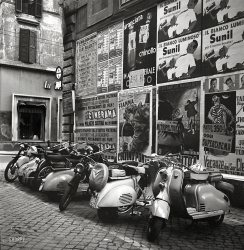
- Cardiff-by-the-Sea: 1960
- ... I don't know for sure).
also Whoa I used to ride my bike there in the 60's and 70's; lots of great folks along there. Anybody ... Posted by Tony W. - 09/17/2011 - 8:23pm -
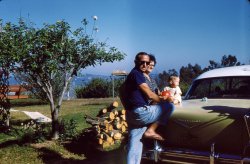
- Proviso Departure: 1943
- ... through the East end of Proviso Yard. It was a very short bike ride in those days.
The bridge in the background appears to be the ... Posted by Dave - 07/30/2012 - 10:04pm -
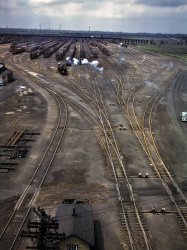
- Rolling Roadblock: 1953
- ... It's a beautiful ride in fall, particularly on a bike. Much of the time the Mississippi and its traffic is visible as well.
... Posted by mpcdsp - 10/12/2013 - 5:22pm -
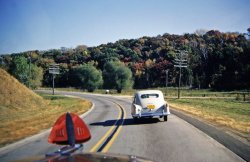
- Washington Flyer: 1921
- ... I wonder what these guys would make of humble, daring "bike trials" rider Danny MacAskill?
If only.... If ... Posted by Dave - 08/13/2013 - 4:09pm -
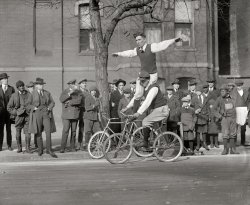
- Hell Gate: 1915
- ... View full size.
I remember this bridge! I used to bike out on Ward's Island & sit next to the base of this bridge! It brings ... Posted by Dave - 10/25/2018 - 10:04am -
![Hell Gate: 1915 "Hell Gate Bridge (New York Connecting Railroad Bridge)," circa 1915. This steel arch span over the East River was completed in 1916. View full size.
I remember this bridge!I used to bike out on Ward's Island & sit next to the base of this bridge! It brings back neat memories; thank you!
The Eighth BridgeI first learned of this bridge from a memorable New Yorker article (Jan 14, 1991) written by Tom Buckley. A few extracts from the opening section are below.
Eight bridges cross the East River, Four of them - the Brooklyn Bridge, the Manhattan, the Williamsburg, and the Queensboro - have been in the news frequently in the past few years. They are the oldest, are owned by the city, and can be crossed free of charge. As a result of these interacting circumstances, they have suffered from prolonged and serious neglect, which has already cost hundreds of millions of dollars to remedy..... The three newest bridges - the Triborough, the Bronx-Whitestone, and the Throgs Neck - are by contrast, pampered darlings. They are owned by the Triborough Bridge and Tunnel Authority, and the tolls it levies are more than sufficient to keep them gleaming with fresh paint....
Whatever their condition, these seven bridges are such conspicuous landmarks that most New Yorkers could probably name at least five of them. Even a cabdriver might be able to identify two or three and drive across them without getting lost. The eighth bridge is another matter. Even in a period of heightened bridge consciousness, scarcely anyone I asked about it over a period of many months was able to provide its name or location, let alone to describe its appearance or function. ...
The Hell Gate was a lot more noticeable in 1917, when it was opened, than it seems to be nowadays. It was the longest and by far the heaviest and strongest steel-arch bridge in the world, at a time when the country rejoiced in such evidence and skill. The bridge was also the final link in one of the costliest privately financed construction projects of the industrial age - the New York Extension of the Pennsylvania Railroad. The extension brought that railroad into Manhattan, and from there to a connection with the New York, New Haven & Hartford Railroad in the Bronx, giving it, for the first time, a direct route to New England.
Hell GateThis bridge is still in regular rail use, by the way--by freight trains and Amtrak passenger rail, between NYC and Boston, Mass. I'm not ashamed to say I get a bit of a thrill when I ride across Hell Gate on the Amtrak.
View Larger Map
Hell Gate ForeverNot only is the Hell Gate bridge still in regular use, it is likely to be the longest surviving bridge of any of the current NYC spans. The February issue of Discover Magazine postulated what would happen to humans' creations if we suddenly disappeared:
Unless an earthquake strikes New York first, bridges spared yearly applications of road salt would last a few hundred years before their stays and bolts gave way (last to fall would be Hell Gate Arch, built for railroads and easily good for another thousand years).
Ok, since nobody's askedI will. Why is it called Hell Gate?
Why Hell Gate?From the Dutch "Hellegat" it refers to a portion of the East River between Astoria, Queens and Ward Island. Between tide driven currents and rocks it was extremely difficult to navigate and hundreds of ships were lost in the area. In September 1876 the worst of the rocks were blasted away by the Corps of Engineers. Navigation continues to be difficult thanks to the tidal flow (the East River isn't really a river but rather a tidal strait) but considerably easier than it was.
StackedI wonder what that smokestack is used for on the far right? It's doing something in this picture cause it's a smokin.
[It's for a coal-fired boiler. You can see the steam farther down. - Dave]
(The Gallery, Boats & Bridges, DPC, NYC)](https://www.shorpy.com/files/images/SHORPY-4a28410u.thumbnail.jpg)
- Dirt Track Daredevils: 1912
- ...
Bikes in the Blood My grandfather was a bike racer. He rode in what we called a "motorcycle scramble" on a dirt track ... to this one.
I remember watching him work on his bike when I was very young (50-plus years ago now).
Although I never was ... Posted by Dave - 01/09/2015 - 12:59pm -
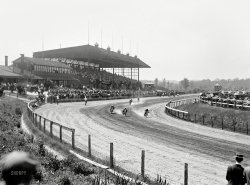
- The Case of the Dented Dodge
- ... and another vehicular misadventure, this time starring the bike that couldn't quite dodge a Dodge. Cameos by two Cadillacs. View full ... Posted by Dave - 01/08/2016 - 9:01pm -
![The Case of the Dented Dodge Oakland circa 1953 and another vehicular misadventure, this time starring the bike that couldn't quite dodge a Dodge. Cameos by two Cadillacs. View full size.
Lane MarkersI don't know exactly how those old lane markers (X) are operated, but there are still some of them in use here in the Atlanta area.
[I believe the hanging "X" signs relate to the rail tracks that appear to be running along the cross street. -tterrace]
19 cent hamburgersThat seems rather high for 1953, especially since they didn't have to go far to get the meat.
X for a CrosswalkI remember seeing those "X" signs used to indicate to drivers that a pedestrian crosswalk was located below.
19¢ hamburgers!Those 19 cent hamburgers would be nice in this day of low wages and tight budgets.
The 19¢ hamburger story continuesIt was probably about this time that the Hi-Fi Drive-In on U.S. 101 in downtown Petaluma, California put up their "19¢ Hamburgers" sign, the "19¢" in huge, neon-and-bulbs-illuminated letters. It was my first lesson in the realities of economics when at some point in the 1960s the "Hamburgers" under the "19¢" was changed to "Fries."
X for Ped Xing?I remember them as markers for pedestrian crossings. We appear to be at the intersection of Telegraph and Grand, looking down Telegraph with Grand as the cross street. The Key System ran down Telegraph, no tracks on Grand:
http://djjr-courses.wikidot.com/soc128:project13-key-system
Cancel Previous TransmissionRailroad crossing is plausible, you can see the overhead trolley wires as well as the tracks. Now I'm confused as to which way we're looking. It's only been fifty plus years since I was at that intersection.
MEATS MEATSYou just don't see signs like that anymore.
Scene todayThanks to the Google Street View Time Machine:
You Have Reached Your DestinationX marks the spot!
(The Gallery, Bicycles, Cars, Trucks, Buses, News Photo Archive, Signal 30)](https://www.shorpy.com/files/images/SHORPY-844.thumbnail.jpg)
- Attention Honeymooners: 1939
- ... golf course. Oh, and attempting to ride the messenger's bike down the toboggan run. I'm sure my parents found other attractions to the ... Posted by Dave - 02/14/2013 - 8:46am -
![Attention Honeymooners: 1939 From August 1939 comes this unlabeled negative, one of a series of pictures taken by Herbert Mayer in Virginia and Maine and residing in the Farm Security Administration archive at the Library of Congress, and its cryptic message. Honi soit qui mal y pense: Happy Valentine's Day from Shorpy! View full size.
No Thanks, Mr. GilbertI think if I was on my honeymoon I'd let Hollywood icon John Gilbert keep his bed while the missus and I got our own. Thanks for the offer though. And I do speak French and I do think evil of your offer.
News item: Aug. 26, 1936
An old saying."Evil be to him who evil thinks."
John GilbertAnother Rudolph Valentino-esque silent film star, John Gilbert died an alcoholic a few years before this photo was taken, but when the sign was painted he would have been one of the leading men of his era.
He was blacklisted by Louis Mayer after a fight between the two at Gilbert's (planned) double wedding, where he would have married Greta Garbo (who jilted him at the alter) while one of Mayer's leading directors, King Vidor, married his on bride, in what would have been a blockbuster event.
Sad tail of one of the early great romantic leads in Hollywood.
[The rest of him sounds sad, too. - Dave]
Into the WoodsIn the late 1940s, my parents, with me in tow, spent several Summer sojourns at the Summit. Being but a tad at the time, my recollections now are somewhat sparse -- mainly the nice lady who ran the gift shop and let me play (carefully) with some of the toys, my first taste of honeydew melon in the restaurant, some time in the swimming pool, finding the odd golf tee whilst rambling on the golf course. Oh, and attempting to ride the messenger's bike down the toboggan run. I'm sure my parents found other attractions to the place, though decency militates against my contemplating them. With the Internet, I could probably find out almost instantly what ever became of the place, but I prefer to remember it as it was then: a renowned haven for harried city dwellers (and apparently the repository for some of a failed actor's furniture).
The Summit Hotel and John Gilbert's BedFrom The National Road in Pennsylvania, pp. 54-55 (available in Google Books) By Cassandra Vivian (Arcadia, 2003): The Summit Hotel
Caption from post card on page: Summit Hotel, Golf and Country Club, (above the clouds) Uniontown, PA
"Sitting atop Chestnut Ridge (the south side), the Spanish mission-style of Mount Summit Inn was once famous as a honeymoon hotel (actor John Gilbert's bed is in its honeymoon suite). It was built in 1900 of native mountain stone to accommodate the tourists of the automobile era. The view is spectacular during all seasons of the year, and a huge veranda surrounds the hotel."
There are additional postcards and text in the adjoining pages.
A billboard so naughty... they had to say it in French.
They forgot to mentionHourly rates.
Mail PouchMail Pouch would paint your whole barn free in return for the ad space, not just part of it.
The bedHere's a postcard of the room.
[But steer clear of the Lupe Velez bathroom. - tterrace]
The photographerThe photographer was my great uncle. He owned a lumber company in Virginia, not sure how his photograph got into the archives.
Someone needs to relearnFrench because the direct translation of 'Honi soit qui mal y pense' is 'evil be to him who evil thinks' buuuut if it is actually Latin it's more along the lines of 'Evil is not welcome'. Side note... "honi" should be "Honni"
[It's archaic, not modern French, and appropriate for the historical context of the phrase. - tterrace]
(The Gallery, Valentine's Day)](https://www.shorpy.com/files/images/SHORPY_8b31619a1.thumbnail.jpg)
- Daytona Beach: 1910
- ...
NASCAR scout I think that's Bill France Sr. on the bike looking for a place to race stock cars.
The Ridgewood Based on the ... Posted by Dave - 07/29/2012 - 6:15pm -
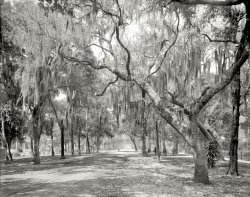
- Shady Rest: 1950
- ... wire.
Sell only 24 cases of salve! That shiny bike has pride of place in this humble scene. What a story that must has been. ... Somebody (maybe a visitor) appears to have a new, nifty bike but otherwise this is a stark picture of the "have-nots" as they have ... Posted by Dave - 09/25/2015 - 2:43pm -
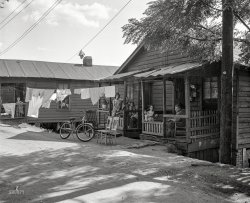
- Inflationary Pressure: 1936
- ... in Korea many years ago.
Horsefeathers I had a bike like this in the 40s and I was a lot scrawnier than this kid. I have lived ... internet.
Ouch My first thought .... riding the bike barefoot seems like it would've really been painful on his tootsies.
... Posted by Dave - 08/13/2013 - 3:39pm -
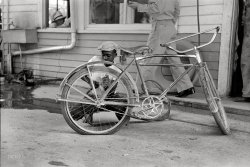
- Harlem River: 1890
- ... now and they are refitting it for a linear park and bike path. It should be open by 2009.
Historic slide show of the Harlem ... Posted by Dave - 07/20/2012 - 1:33pm -
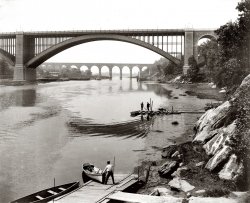
- Johns Hopkins: 1903
- ... Monument was a favorite destination when we felt like a bike ride.
The main attraction was a great view of our town and the cost ... Posted by Dave - 07/19/2012 - 12:57pm -
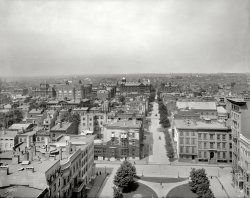
- SuperCenter: 1941
- ... the railroad tracks are long gone, replaced by an asphalt bike/ped trail, which young hiker seems to be enjoying.
Minus a chimney ... few hundred yards west of the store. This bridge is now a bike trail but was placed into service as a highway bridge when a bridge on the ... Posted by Dave - 02/28/2018 - 3:08pm -
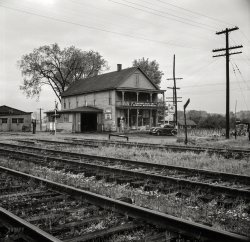
- Genesee Street: 1904
- ... sort. -tterrace]
Cyclecuse, NY Has to be the most bike friendly city in the early 1900's. You've posted many street scenes from ... Rack it Apparently the bank wasted their money on the bike racks. They don't seem to be very popular.
When we were 21 ? An ... Posted by Dave - 06/25/2014 - 2:19pm -
![Genesee Street: 1904 Syracuse, New York, circa 1904. "Genesee Street." Early-1900s standbys include the usual assortment of painless dentists, and a "Misfit" clothing parlor. 8x10 inch dry plate glass negative, Detroit Publishing Company. View full size.
Low self-esteemOddly enough, the majority of the people are clustered around Meyer's Misfits which perhaps would indicate they didn't have a very high opinion of themselves. (Wonder if Marilyn Monroe got her wardrobe there for her movie of the same name).
[Looks like a youth outing of some sort. -tterrace]
Cyclecuse, NYHas to be the most bike friendly city in the early 1900's. You've posted many street scenes from numerous cities, but I can't recall any with so many bicycles.
Rack itApparently the bank wasted their money on the bike racks. They don't seem to be very popular.
When we were 21 ?An early film, perhaps? There was to be one in 1921, but I couldn't find anything earlier.
[Large movie theaters and feature-length films were still a bit in the future in 1904. The Bastable offered live theater, both vaudeville and plays, such as "When We Were Twenty-One," a 1901 four act comedy by H.V. Esmond. It was also filmed in 1915 and adapted for another in 1930. -tterrace]
Darned treesIt's hard to see, but this is pretty much where the image was taken. If you go straight down the tree-lined path, almost all of the buildings on the right hand side seem to be there (actually the Salt Springs Bank on the close left is also still there without its pretty entry).
View Larger Map
(The Gallery, Bicycles, DPC, Stores & Markets, Syracuse)](https://www.shorpy.com/files/images/SHORPY-4a12107a.thumbnail.jpg)
- White Castle: 1910
- ... parked that way today, and one is right next to an unused bike rack on the sidewalk.
Hometown Bias I wonder if they only had an ... Posted by Dave - 10/17/2013 - 11:44am -
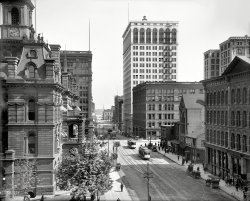
- Petite Visite à Grosse Ile: 1900
- ... Channel into the Wayne County Bridge for use by vehicular, bike and pedestrian traffic. The rail tracks across the island were replaced by ... Posted by Dave - 07/08/2014 - 12:36pm -
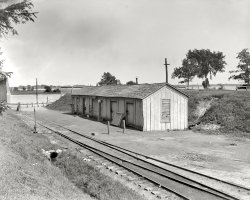
- Bicycle Queen: 1959
- ... Annette: going to a soda shop, or the movies, or even a bike ride.
She was the sweetheart of my pre-teen years!
One Classy Lady ... Posted by Dave - 03/01/2014 - 5:01pm -
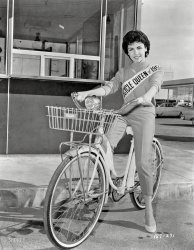
- Little Creek: 1938
- ... Fender, Batman! The holes in the rear fender of the bike were used to thread heavy string or twine to create a guard to keep a ... Posted by Dave - 08/13/2013 - 3:39pm -
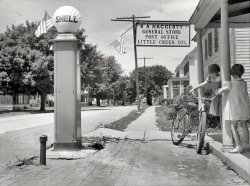
- Candy Kitchen: 1908
- ... full size.
Handlesbar Net I like the net on the bike, and note correct usage: two handles, one bar.
[Kind of like ... Posted by Dave - 08/13/2013 - 4:09pm -
![Candy Kitchen: 1908 Grand Rapids, Michigan, circa 1908. "View of Monroe Street showing Hotel Pantlind." Not to mention the Candy Kitchen and Ice Cream Parlor. 8x10 inch dry plate glass negative, Detroit Publishing Company. View full size.
Handlesbar NetI like the net on the bike, and note correct usage: two handles, one bar.
[Kind of like teethbrush, or eyesglasses. - Dave]
Don't use the tower clock to sync your pocket watchThe clock on the tower says that it is 9:34, but the shadows, especially the awnings on the hotel, appear to be more middle of the day, noontime, shadows to me.
Amway Grand PlazaThe old Pantlind Hotel is now the east portion of the Amway Grand Plaza Hotel.
NowadaysIt would be called Kandy Kitchen.
Spacious Streetscape It's positively capacious! No bus shelters, benches, trees or overflowing litter receptacles. There aren't even any parking meters or lampposts to properly lock those newfangled bicycles against.
So many peopleBy my count there are over 40 people (and one dog) visible in the picture. That's more than in most cityscape pictures, even ones in much larger cities than Grand Rapids.
Cover StoryWhat's the story behind the tarps that are covering some of the store front windows?
(The Gallery, Bicycles, DPC, Streetcars)](https://www.shorpy.com/files/images/SHORPY_4a23403a.thumbnail.jpg)
- Sally's Harley: 1937
- ... as much.
More on Sally I learned to ride a "Big Bike" in 1965 -- my buddy's 1939 Harley 61. At 150lbs I was not much of a match ... I ride my 1980 GoldWing with pride at 35 years on the bike.
(The Gallery, D.C., Harris + Ewing, Motorcycles) ... Posted by Dave - 05/26/2014 - 5:58pm -
